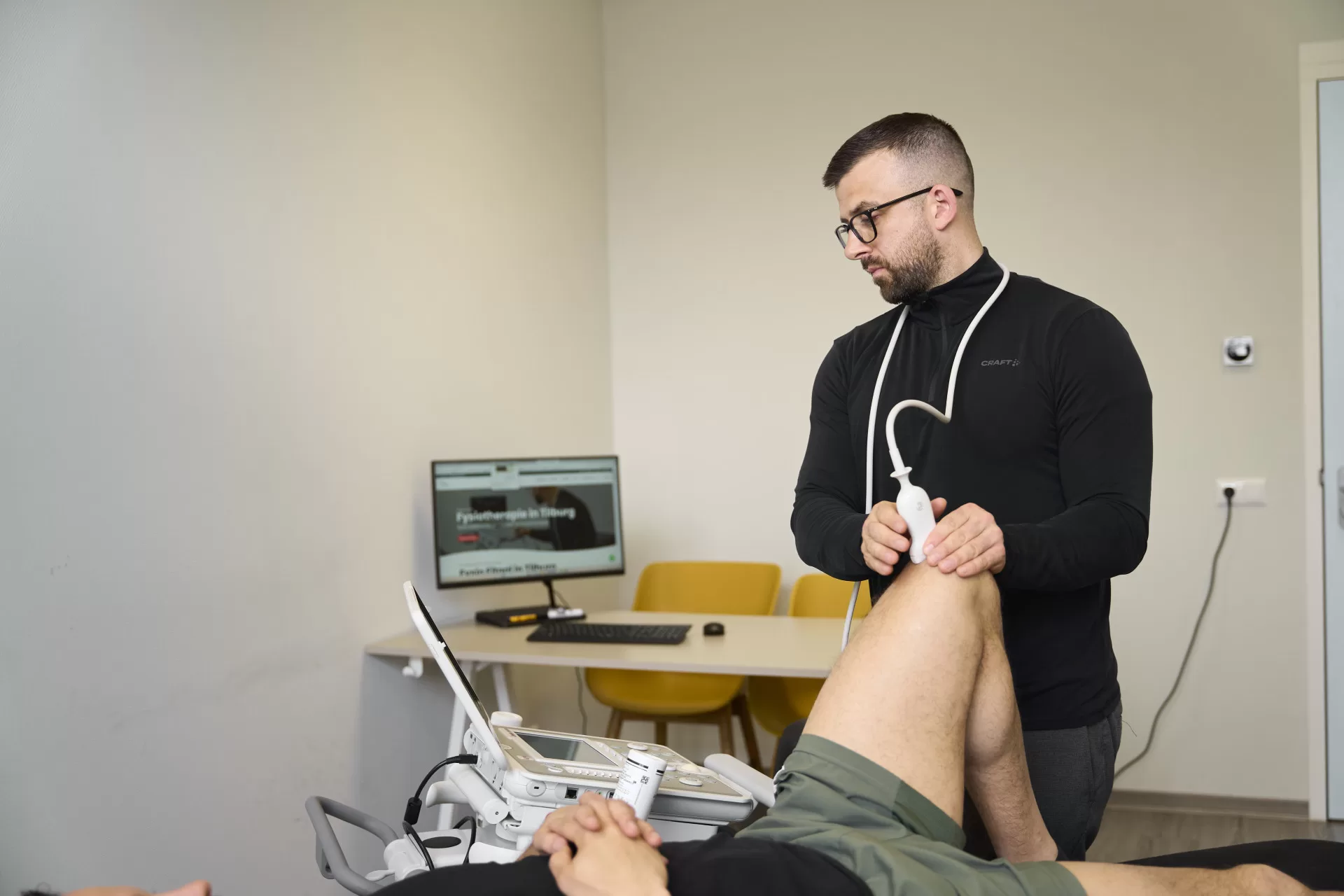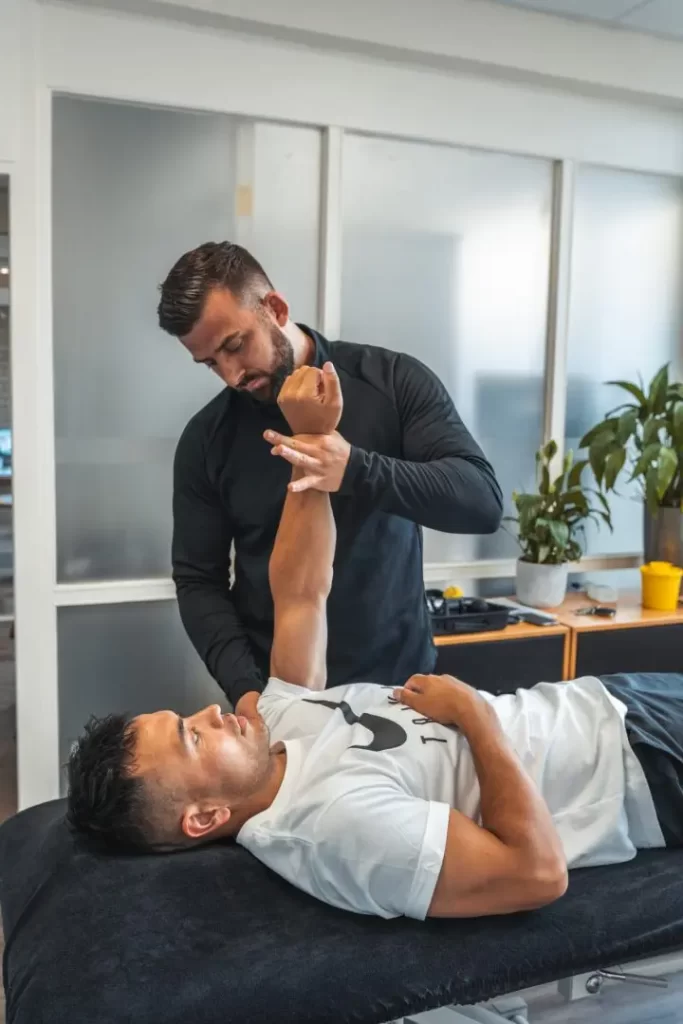Cartilage rehabilitation

When do we speak of cartilage damage?
Only an orthopaedist or surgeon can use imaging studies to decide whether the symptoms are appropriate for cartilage damage. To get a good and reliable picture of the cartilage damage, imaging examination is necessary. Should this not give sufficient results, an additional decision can be made to obtain a better picture of the severity of the cartilage injury by means of keyhole surgery (arthroscopy).
Cartilage damage can be classified into five different degrees, according to the 'International Cartilage Repair Society' scoring system:
- Grade I: soft site with less resistance than the surrounding, healthy cartilage.
- Grade II: superficial cracks or defects in the cartilage surface, less than half the total thickness.
- Grade III: deep cracks or fissures in the cartilage surface, more than half the total thickness.
- Grade IV: tear to the subchondral bone, affecting the total thickness of the cartilage surface.
- Grade V: impairment of the total thickness of the cartilage surface with involvement of the subchondral bone ('full-thickness defect').
In addition to an MRI, additional radiographs are necessary to paint a good picture of the situation. This includes ruling out any loose bone fragments and identifying signs of osteoarthritis.
Restoring or improving the quality of the affected cartilage tissue can be done with various surgical techniques. Below, we explain the four most common techniques from which we are allowed to perform many rehabilitations at our physiotherapy practice in Tilburg.
Types of procedures
Autocart procedure
AutoCart is a surgical procedure, in which cartilage lesions are treated using only the patient's own material/tissue. This involves using a SabreTooth razor blade to remove 3 or 4 mm cartilage particles. These are then collected in the GraftNet device and then transferred into a 1ml application syringe. After mixing with some PRP, the particles are inserted into the lesion using an application cannula and then fixed with autologous thrombin solution produced by the thrombonator device. At the end, the entire construct is sealed with an additional layer of a PRP/Trombin mix.
An autocart procedure is regularly carried out by Bergman Clinics which we work closely with as a practice.
Microfracture (=Icepicking)
Microfracture is a technique used to treat cartilage injuries. In this operation, holes are made in the underlying bone to allow stem cells from the bone marrow to repair the cartilage defect. This technique is usually used if the defect has not been previously treated and is no larger than 1 to 1.5 cm2. It is done through keyhole surgery.
Depending on the location of the cartilage injury, patients often need to use crutches to walk unloaded/without support for 6 weeks. In some cases, patients can load their knee but need to use a brace to keep the knee stretched while walking for 6 weeks.
Hydrogel
Prof Marcel Karperien and his colleagues at the TechMed Centre at the University of Twente, with support from ReumaNederland, have developed a hydrogel in which damage to cartilage can potentially be repaired. Through keyhole surgery, the damaged cartilage can be filled by an injection of the hydrogel. This gel is liquid, allowing the damaged surface to be filled perfectly. After various studies in which the hydrogel was tested on horses, among others, the hydrogel has now also been tested on humans for the first time.
The hydrogel is currently being further developed by the company Hy2Care, of which Marcel Karperien is one of the founders. This company, together with orthopaedists at the UMC Utrecht, now doing initial tests on several dozen people. Should this method of cartilage repair for defects smaller than 2cm2 prove successful, it may be possible to investigate its effect in complaints such as osteoarthritis.
At Physio Fitaal, we are currently assisting the first patients in the Netherlands with a hydrogel repair.
Autologous Chondrocyte Implantation or Transplantation (ACI or ACT)
This type of cartilage transplantation is used for larger cartilage defects. The treatment consists of two procedures. In the first procedure, 2 or 3 small particles of cartilage are first taken from a relatively unloaded part of the joint through keyhole surgery. The cartilage cells are then grown in a laboratory. When there are enough new cells, it is possible to proceed to the second operation/surgery.
In the second keyhole surgery/operation, the new cartilage cells are inserted into the cartilage defect. This is usually about 6 weeks after the first surgery.
The medicine used in this procedure is 'Spherox'. Spherox consists of globules. These spheres are formed from cartilage cells grown by a special method. The cartilage defect is cleaned and the damaged tissue is removed. The globules are then applied to the cleaned cartilage. The globules adhere to the cartilage within about 20 minutes.
The ACI procedure is carried out regularly by the ETZ Tilburg/Waalwijk which we work closely with as a practice. ETZ is one of 4 cartilage centres in the Netherlands.
After all these operations, long-term and intensive physiotherapy is needed to ensure that cartilage repair proceeds properly. Cartilage always recovers very slowly, so loading the knee too quickly can negate the effect of the surgery. It is also important to exercise the knee properly so that it does not become stiff and you can regain full use of it. In total, this rehabilitation takes about one year.
Remote consultation
Are you looking for expert advice regarding an upcoming cartilage rehabilitation but is distance a barrier? We would be happy to share our expertise and experience through a digital consultation. The physiotherapists at Fysio Fitaal in Tilburg have extensive experience in guiding and rehabilitating cartilage injuries. We would like to provide you with all the necessary information and advice to start rehabilitating successfully.
During the digital consultation, you will have plenty of time to ask questions or share any concerns you may have. We listen attentively and adapt our advice to your specific situation. There is also the possibility of arriving at a tailor-made rehabilitation plan in collaboration with your treating physiotherapist. Taking into account medical history, goals and physical condition.
Our approach is a combination of known scientific knowledge and our own practical experience. You can be confident that the advice and rehabilitation protocol is based on the latest developments in the field.
How does it work?
- Schedule appointment: Contact us via the contact form to schedule an appointment for your digital consultation. Preferably, we use ZOOM.
- Preparation: When the appointment is scheduled, you will receive an e-mail from us in which we will ask you to send us relevant medical information and documentation so that we can prepare properly for our interview.
- The consultation During the digital consultation, we will go through the situation with you, all your questions you have can be asked during this mo ment and we will give advice on what steps you can go through during your rehabilitation.
- Follow-up: After the consultation, you will receive a summary of the conversation and the suggested treatment plan. We are of course at your disposal for any further questions or, if required, physical guidance during the process.
- Evaluation: Our advice is to schedule an evaluation moment every 12 weeks. This can be done online, but you are also welcome at our physiotherapy practice in Tilburg. We work with a unique test and measurement system mainly based on mapping left-right differences and norm values related to strength and mobility.
So if you live further away but still want to use our expertise, don't hesitate and contact us! Together, we will work on your recovery with a thoughtful plan, regardless of the distance.
What does the health insurer reimburse?
Physiotherapy after surgery is reimbursed only when a condition is on the chronic list of physiotherapy. For example, surgery as a result of a bone fracture or after surgery on your knee, such as repairing your anterior cruciate ligament or fitting a knee prosthesis. You also need a referral from the doctor. Also, you always pay the deductible. However, this is often already consumed due to the cost of the surgery. What else is important to know:
- The authorisation runs for a maximum of 12 months after the start of rehabilitation(the first physiotherapy treatment)
- The insurer will reimburse all costs from the 21st treatment onwards
- The first 20 treatments come out of your supplementary package as far as possible
Why choose Fysio Fitaal?
Specialised physiotherapists with expertise in cartilage problems
A tailor-made rehabilitation programme tailored to your goals
Modern facilities with space for exercise therapy and sports-specific rehabilitation
Collaboration with orthopaedists and specialists for a multidisciplinary approach

Traumatic osteoarthritis after a knee injury
Post traumatic osteoarthritis is a subtype of osteoarthritis and occurs after a significant injury

Meniscus injury
A meniscus injury is one of the most common knee problems in Physiotherapy

Injury to the posterolateral complex
In an injury where the forces are great enough, there can be actual damage from...
Making an appointment at FysioFitaal
We work from multiple locations in Tilburg, always close by for professional and accessible physiotherapy. Fill in the contact form and we will contact you soon. Together, we will work on your recovery!

